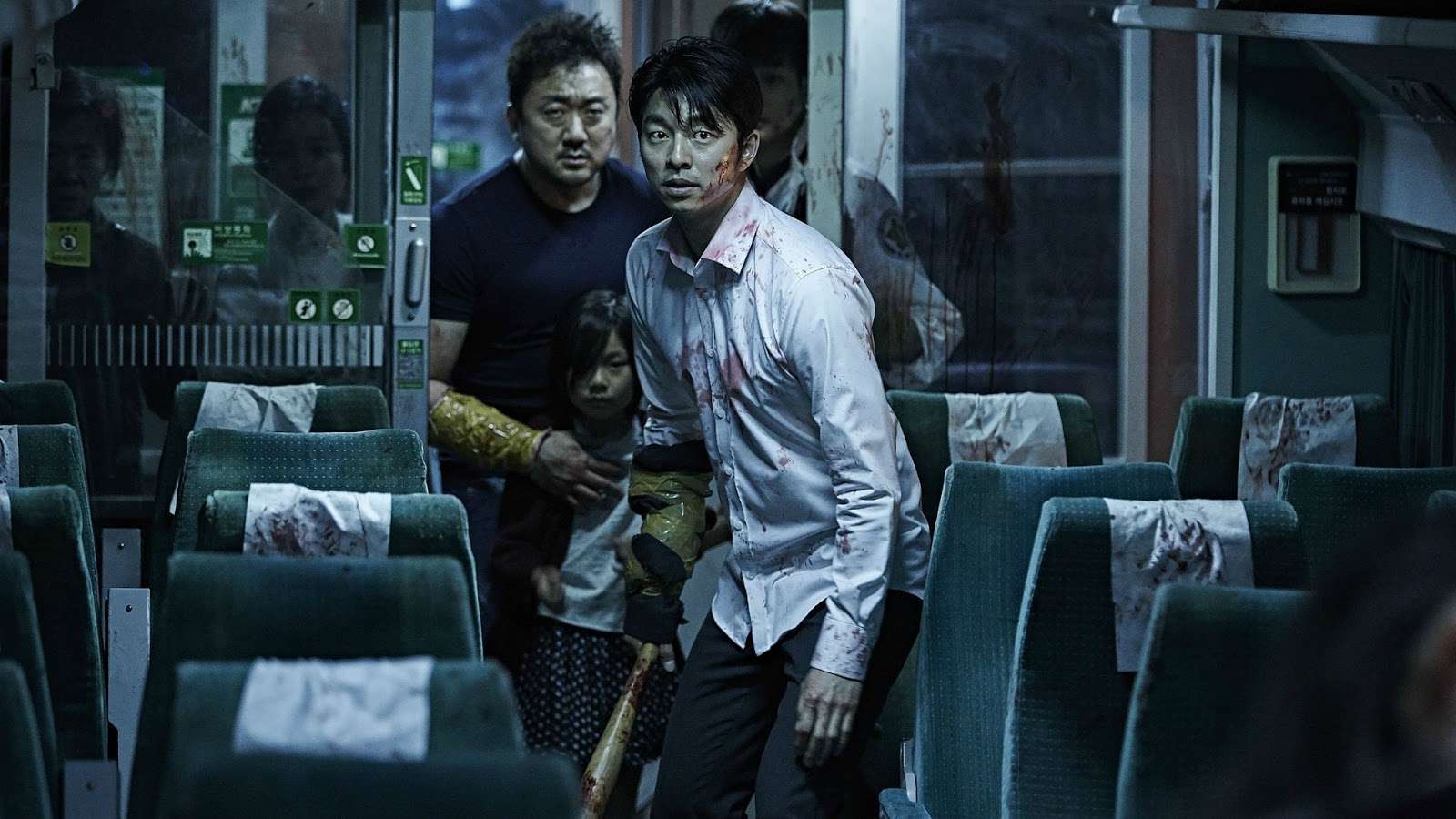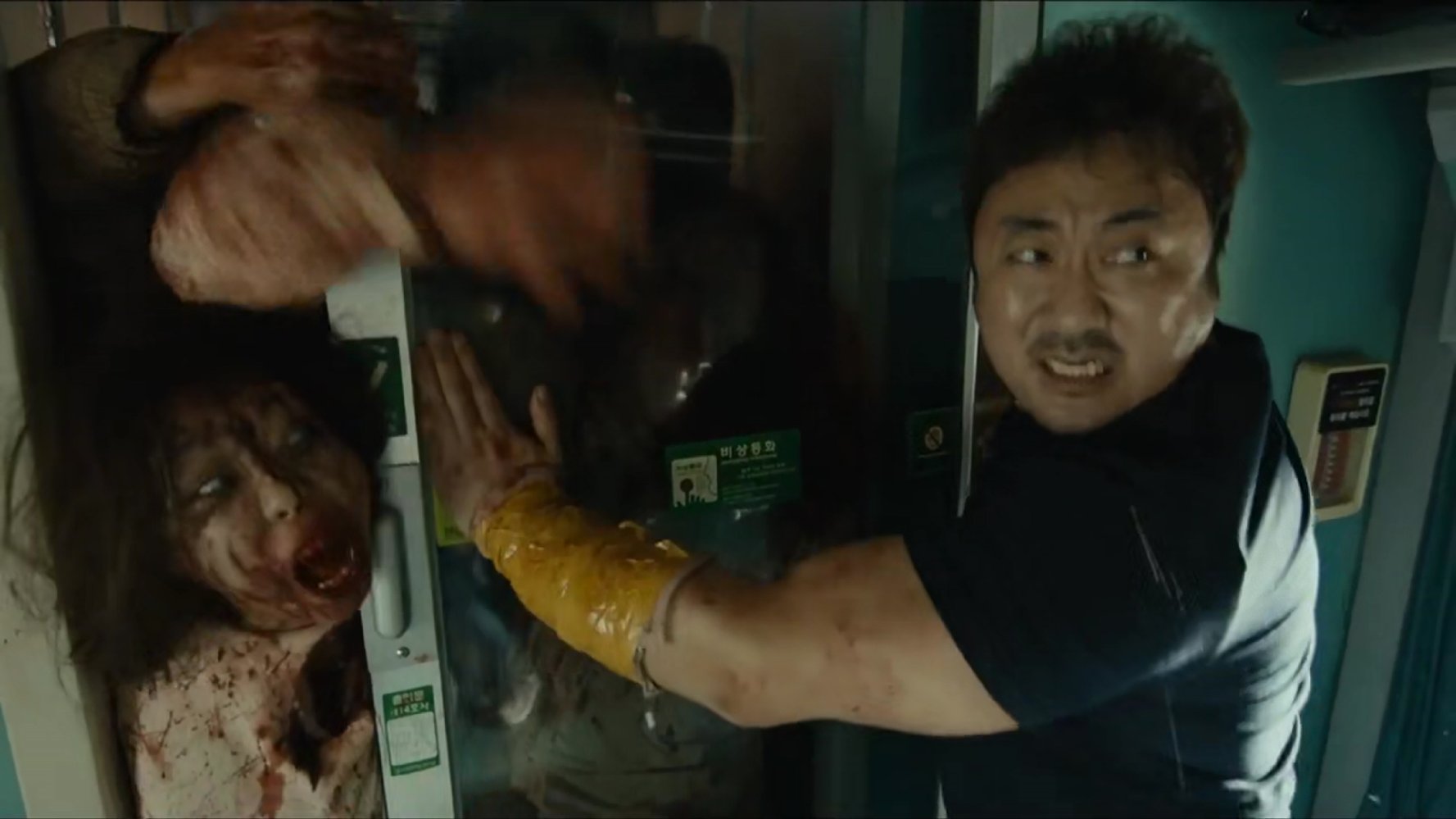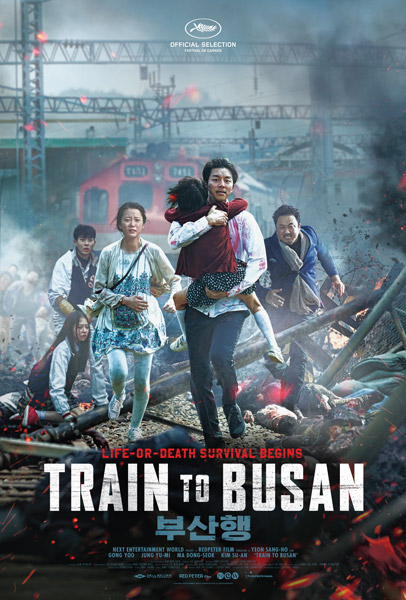(Busan Haeng)
South Korea. 2016.
Crew
Director/Screenplay – Yeon Sang-ho, Producer – Dong-ha Lee, Photography – Hyung-deok Lee, Music – Jang Young-gyu, Visual Effects – Digital idea, Visual Effects Supervisor – Hwang-su Jung, Makeup Effects – Hyo-kyun Hwang & Tae-yong Kwak, Production Design – Mok-won Lee. Production Company – Redpeter Film.
Cast
Yoo Gong (Seok Woo), Soo-an Kim (Soo-an), Dong-seok Ma (Sang Hwa), Yu-mi Jeong (Sung Gyeong), Eui-sung Kim (Yong-Suk), Woo-sik Choi (Young Gook), Ahn So-hee (Jin-hee)
Plot
Seok Woo, a fund manager in Seoul, realises that he has been neglectful to his daughter Soo-an on her birthday. She has only one wish – to visit her mother in Busan – and Seok Woo agrees to take her the next day. They set out on the train. However, an ill woman stumbles on board and then attacks a hostess. In rapid course, the hostess and then the rest of the passengers in the carriage are turned into ravening zombies. With the entire train swiftly becoming infected, various of the passengers manage to close the compartment doors. The driver tries to clear the way ahead so they can make it to safety in Busan but the spread of infection and the self-interested actions of those on board endanger every step of the journey.
The zombie film has become legion in the 2000s/10s following high-profile successes such as Resident Evil (2002), 28 Days Later (2002), Dawn of the Dead (2004) and Shaun of the Dead (2004). All of these draw on the basics that had been established by George Romero back in his original trilogy. A great many imitators, usually of the low-budget variety, jumped onto the zombie revival before others soon found that it was a genre severely limited in new and original plot possibilities. That is why the majority of the zombie films from the latter half of the 2000s onwards have become tongue-in-cheek and/or gonzo mash-ups that place zombies together with the most absurdly improbable of elements.
A sampling of titles might include Zombie Strippers! (2008), Attack of the Vegan Zombies! (2009), Santa Claus vs. the Zombies (2010), Bong of the Dead (2011), Cockneys vs Zombies (2012), Pro Wrestlers vs Zombies (2014), Zombeavers (2014), MILFs vs Zombies (2015), Scouts Guide to the Zombie Apocalypse (2015), Attack of the Lederhosen Zombies (2016), Pride and Prejudice and Zombies (2016) and Fat Ass Zombies (2020), among numerous others. This gonzo take has become so prevalent that the serious zombie apocalypse film has now become a dying breed. (For more detail see Zombie Films).
Train to Busan is one of the few recent zombie films to take itself seriously. I was intrigued to see what it did with the zombie theme as it had gotten some great word of mouth at various fantastic festivals. Indeed, it was one of the few South Korean films that one can think of – since I Saw the Devil (2010) as far as I am aware – to get a widespread North American release that was not relegated to arthouse theatres or Korean niche markets.

Train to Busan does nothing particularly original with the zombie film. If anything, it builds on our assumptions with the familiar – such that it never concerns itself with the causes of the apocalypse. About the only familiar touch we don’t get is the need to shoot zombies in the head to kill them, although here they do develop a new vulnerability in not being able to see in the dark.
The only real spin on the familiar that Train to Busan offers is to contain the action on a train. Here the filmmakers have taken the basic premise from Snakes on a Plane (2006) and placed the resident menace aboard a moving vehicle. The train seems to be a new venue for this type of drama and we have seen the likes of The Asylum’s Snakes on a Train (2006), as well as Horror Express (1972) and Alien Express (2005) with aliens aboard a train, Howl (2015) featuring a werewolf on a train, and Red Eye (2005) and Train of the Deaf (2007) featuring haunted trains. For the record, we had previously had zombies on a plane with Flight of the Living Dead: Outbreak on a Plane (2007) and Quarantine 2: Terminal (2011).
It is not until some way into the film that Train to Busan kicks into high gear. The sequence that did it for me was the one with the various passengers stopped at a station and going out to get help only to be forced to retreat as they encounter a massive horde of zombies and in the race of the separated stragglers to get back to the train as it departs. This is followed by the equally intense sequence where the three men make the decision to rescue the handful of survivors trapped in the bathroom cubicle, which requires them passing through three carriages filled with zombies and fighting them with bare hands in the confined space. In these sequences, Yeon Sang-ho generates a considerable degree of tension.

Yeon Sang-ho does perhaps over-emphasise the theme of the need for group cooperation over individual survival of the fittest – in this regard, Yoo Gong, cast as the businessman who has been inattentive to his daughter, has his story arc spelt out fairly much from the introductory scenes. The other bit I did have trouble believing was that the glass sliding doors separating the carriages would hold so easily against the zombie hordes pressed against them where, it would appear from one piece of dialogue, there is nothing more than a latch holding them closed and the zombies lacking the intelligence to figure out how to slide a door open.
However, when it comes to pieces of drama like the race to get across the Busan train yard and with several of the key players trapped in a triangle formed underneath two collided trains that are arcing electricity at the same time as the zombie hordes are pressed against the windows above that are threatening to break, not to mention the concluding piece where the engine car gets away while dragging a zombie horde along the track behind it, a mass that keeps getting bigger as more zombies throw themselves on top, you realise that Yeon Sang-ho has done something fairly remarkable with the zombie film. Indeed, he even does so to such an extent that one’s usual antipathy to fast-moving zombies fails to kick in.
Around the same time as this, Yeon Sang-ho also released the animated Seoul Station (2016), which acts as a prequel to the events of Train to Busan. He subsequently made a live-action sequel with Peninsula (2020).
Surprisingly, Train to Busan was the first live-action film for Yeon Sang-ho. As director, he had previously made the animated films The King of Pigs (2011) and The Fake (2013), both of which are non-fantastical. He subsequently went on to make the live-action psychic powers/superhero film Psychokinesis (2018), the tv mini-series Hellbound (2021) and the SF film Jung_E (2023).
Trailer here

